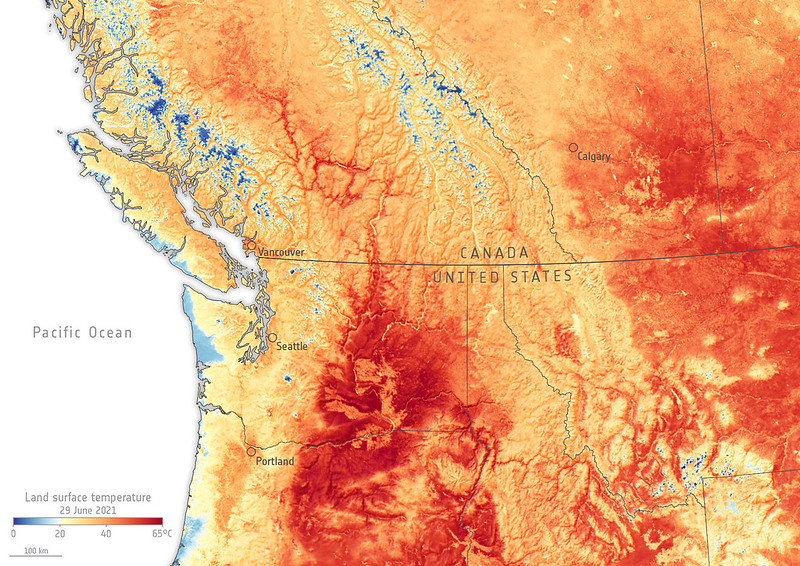In the summer of 2021, Canada’s all-time temperature record was smashed by almost 5℃. Its new record of 49.6℃ is hotter than anything ever recorded in Spain, Turkey or indeed anywhere in Europe.
The record was set in Lytton, a small village a few hours’ drive from Vancouver, in a part of the world that doesn’t really look like it should experience such temperatures.
Lytton was the peak of a heatwave that hit the Pacific Northwest of the United States and Canada that summer and left many scientists shocked. From a purely statistical point of view, it should have been impossible.
I’m part of a team of climate scientists who wanted to find out if the Pacific Northwest heatwave was unique, or whether any other regions had experienced such statistically implausible events. And we wanted to assess which regions were most at risk in future. Our results are now published in the journal Nature Communications.
Tracking these outlier heatwaves is important not just because the heatwaves themselves are dangerous, but because countries tend to prepare to around the level of the most extreme event within collective memory. An unprecedented heatwave can therefore provoke policy responses to reduce the impact of future heat.

For instance, a severe heatwave in Europe in 2003 is estimated to have caused 50,000-70,000 excess deaths. Although there have been more intense heatwaves since, none have resulted in such a high death toll, due to management plans implemented in the wake of 2003.
One of the most important questions when studying these extreme heatwaves is “how long do we have to wait until we experience another similarly intense event?” This is a challenging question but, fortunately, there is a branch of statistics, called extreme value theory, that provides ways in which we can answer that exact question using past events.
But the Pacific Northwest heatwave is one of several recent events that have challenged this method and should not have been possible according to extreme value theory. This “breakdown” of statistics is caused by conventional extreme value theory not taking into account the specific combination of physical mechanisms, which may not exist in the events contained in the historical record.
Implausible Heat Is Everywhere
Looking at historical data from 1959 to 2021, we found that 31% of Earth’s land surface has already experienced such statistically implausible heat (though the Pacific Northwest heatwave is exceptional even among these events). These regions are spread all across the globe with no clear spatial pattern.
We also drew similar conclusions when we analyzed “large ensemble” data produced by climate models, which involve computers simulating the global climate many times over. These simulations are extremely useful for us, since the effective length of this simulated “historical record” is far larger and thus they produce many more examples of rare events.
However, while this analysis of the most exceptional events is interesting, and cautions against using purely statistical approaches for assessing the limits to physical extremes, the most important conclusions of our work come from the other end of the spectrum — regions that have not experienced particularly extreme events before.
Some Places Have Got Lucky — So Far
We identified a number of regions, again spread across the globe, that have not experienced especially extreme heat over the past six decades (relative to their “expected” climate). As a result, these regions are more likely to see a record-breaking event in the near future. And with no experience of such a huge outlier, and less incentive to prepare for one, they may be particularly harmed by a record heatwave.
Socioeconomic factors, including population size, population growth and level of development will exacerbate these impacts. As a result, we factor in population and economic development projections in our assessment of the regions that are most at risk globally.
Our at-risk regions include Afghanistan, several countries in Central America and far eastern Russia among others. These regions may be surprising, since they are not those people typically think of when considering extreme heat impacts of climate change like India or the Persian Gulf. But those countries have recently experienced severe heatwaves and so are already doing what they can to prepare.
Central Europe and several provinces in China, including the area around Beijing, also appear to be vulnerable when considering the extremeness of the record and population size, but as more developed areas they are likely to already have plans to mitigate severe impacts.
Overall, our work raises two important points:
The first is that statistically implausible heatwaves can occur anywhere on the Earth, and we must be very cautious about using the historical record in isolation to estimate the “maximum” heatwave possible. Policymakers across the globe should prepare for exceptional heatwaves that would be deemed implausible based on current records.
The second is that there are a number of regions whose historical record is not exceptional, and therefore is more likely to be broken. These regions have been lucky so far, but as a result, are likely to be less well prepared for an unprecedented heatwave in the near future. It is especially important that these regions prepare for more intense heatwaves than they have already experienced.
This article is republished from The Conversation under a Creative Commons license. Read the original article.
Previously in The Revelator:
How Cities Are Preparing for the ‘Silent Killer’ of Extreme Heat


